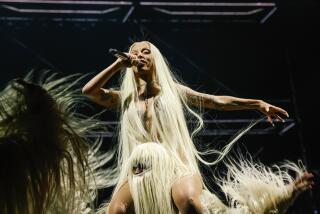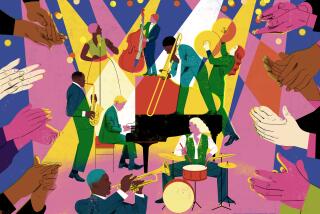JAZZ REVIEW : HUMMING ALONG AT THE QUEEN MARY
- Share via
It says something about the organizers of the three-day Queen Mary Jazz Festival, which began Friday evening, that their choice for a host was “Late Night With David Letterman” band leader Paul Shaffer, who is to a class jazz act what a tugboat is to the Queen Mary.
Sample Shaffer sally: “I wanna bring this cat on. He’s played with a lotta cats. He’s recorded with Marvin Gaye, so you know where this cat is coming from.”
The cat in question was Leslie Drayton, a trumpeter who, after leading a superior but unsuccessful big jazz band, formed a seven-piece funk group in which, with soprano sax, synthesizers, congas, percussion and keyboards, he sounds like a poor man’s Chuck Mangione.
Drayton still has his jazz chops, however, as he showed during a series of eloquent cadenzas in a blues, with bassist Charles Meeks doubling engagingly on harmonica.
Drayton battled a sound system that hobbled the entire evening. There was a continuous low-register hum; basses were over-amplified; rhythm sections during the Diane Schuur and Mercer Ellington sets were in aural disarray.
Ellington was at a double disadvantage. Despite the revolving stage there were long waits between sets. The band hit the stage at 11:20 p.m. and was not through until 1 a.m., by which time most of the audience had drifted away.
This was unfortunate for Anita Moore, Ellington’s vocalist (on stage at 12:35 a.m.). Her rich, mellow, well-controlled voice has matured over the years. It was a rare pleasure to hear the lyrics to Billy Strayhorn’s “Passion Flower,” and the seldom heard verse of “I Got It Bad.”
The contrast between Moore and Schuur was enlightening. Schuur has a splendid vocal instrument, as she made clear during such gimmick-free pieces as “Love Dance.” A talented pianist, she accompanied herself during half the set. But her voice is like an engine that now and then overheats. The sudden forced high notes, the touches of ersatz Dinah Washington, the passion tried for in “Reverend Lee” by repeating the phrase “Do it to me” rapidly 24 times, were not substitutes for true emotion.
She sang “It Don’t Mean a Thang” but rhymed it with swing rather than swang , which at least would have been consistent. (Anita Moore, of course, has no need to aim for a black sound; it comes to her naturally.) With careful guidance and less affectation, Schuur could be a focused, convincing jazz singer.
The Ellington orchestra achieved, when the engineers and the arrangements allowed it, enough of the echt Ellington sound to recall the Duke’s unique legacy. Despite the use of six men recruited locally, the brass section came through with fiery cohesion. The saxes lacked the strong alto lead and unification that was long a part of the band’s identity.
Barry Lee Hall on trumpet was true to tradition in his superb recreation of Cootie Williams’ “Do Nothing Til You Hear From Me.” Gerald Wiggins at the piano and his son J.J. Wiggins on bass beat the sound system and came across well.
The very early Ellington tunes, “Birmingham Breakdown” and “Hot and Bothered,” were rendered with a quaintly charming authenticity. The low note was a reggae number in which the flutist dismembered his flute for comedy value.
Earlier, the Rippingtons displayed some of the more valid values of fusion music, blending alto sax, leader Russ Freeman’s guitar, and keyboards (with David Benoit on piano) in a manner that suggested, at times, a more accessible and less abstract Weather Report. Benoit’s “Sunset Island” stood out in an uneven set of originals.
Music of this genre is light years from the blues or from soul, yet on its own terms it is acceptable. Paul Shaffer took over Freeman’s synthesizer for one number.
Attendance was 5,800. Capacity on the harbor (some 200 yards from the Queen herself) is 10,200.
More to Read
The biggest entertainment stories
Get our big stories about Hollywood, film, television, music, arts, culture and more right in your inbox as soon as they publish.
You may occasionally receive promotional content from the Los Angeles Times.










